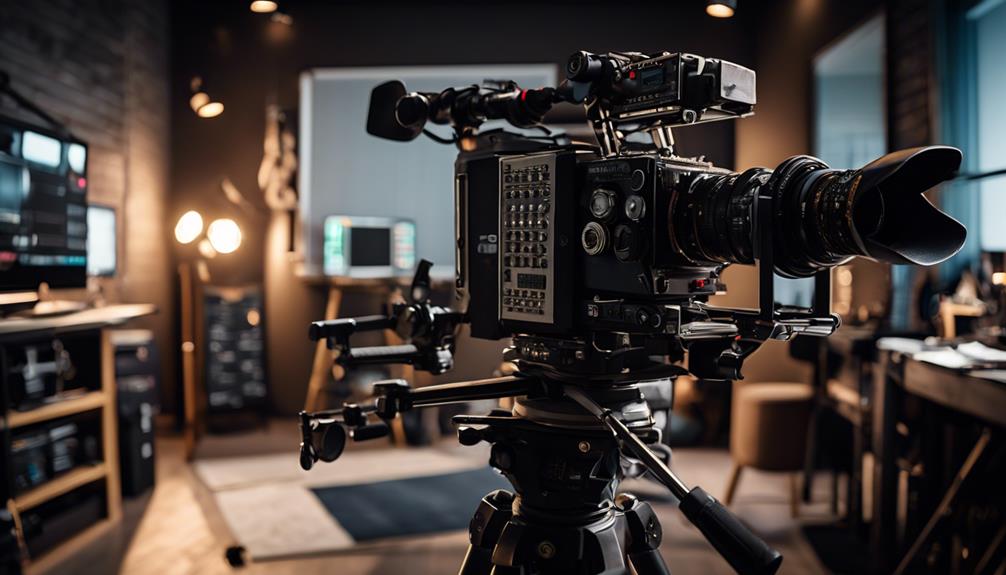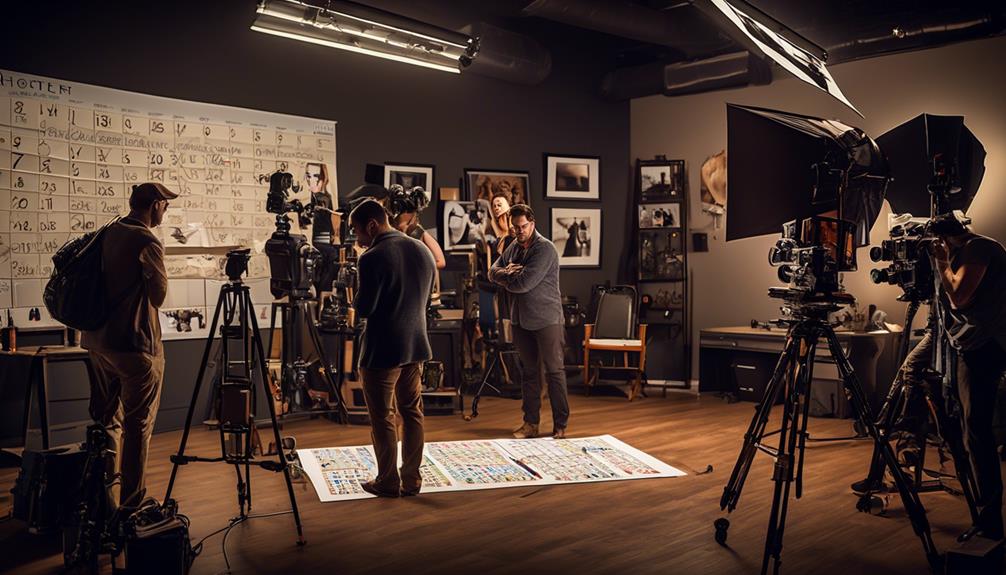Please note this post may contain affiliate links picked by me (Jay) that I have deemed may be of interest or relevant to you the reader of this.
These links do not affect the cost of the thing if you decide to purchase but i may get a little money if you choose to purchase.
For more information on my affiliate link policy click here.
As a photographer, I've come to realize that a picture may be worth a thousand words, but without a solid business plan, it might not be worth a single dollar.
In the competitive world of photography, it's not just the quality of your shots that counts; it's also the strategic framework that supports your business.
I've distilled my experiences and research into five key strategies that are essential for any photographer aiming to turn their passion into a profitable venture.
These strategies encompass understanding your unique market niche, building a brand that resonates, meticulously planning your business's trajectory, amplifying your online presence, and ensuring your financial foundation is as stable as your tripod.
Each element is a pivotal piece of the puzzle, and I'm eager to share how they interlock to elevate a photography business from a mere hobby to a thriving professional enterprise.
So, let's explore these strategies together, and I'll show you how each one can be a game-changer for your business.
Define Your Niche Market

Identifying your niche market is a crucial step in carving out a unique space within the competitive world of photography. As an avid photographer, I've learned that success hinges on not just the click of the shutter, but the strategic, behind-the-scenes market research that pinpoints who your ideal customers are. It's about understanding their needs, desires, and the specific moments they want to capture.
I've immersed myself in analyzing trends, engaging with communities, and identifying gaps in the market where my vision can shine. It's not just about standing out; it's about connecting on a level that resonates with a particular group's ethos. Whether it's vintage-inspired wedding photography or high-octane sports action shots, I ensure my style aligns perfectly with client expectations.
Investing in the right equipment is also non-negotiable. I meticulously select gear that elevates my work within my niche. This isn't about splurging on the latest gadgets; it's a calculated equipment investment that enhances my ability to deliver distinctive, innovative imagery. Every lens, every flash unit becomes an extension of my creative intent, empowering me to not just meet but exceed the demands of my chosen niche market.
Develop a Strong Brand
Crafting a compelling brand identity is as essential to a photography business as a camera is to a photographer, serving as the visual and emotional touchstone that connects me to my audience. It's not just about snapping stunning shots; it's about weaving an unforgettable narrative that resonates with my clients on a personal level. A strong brand evokes emotion, establishes credibility, and solidifies my reputation in the competitive market.
To truly captivate and communicate my brand's essence, I focus on:
- Logo Design: My logo is the cornerstone of my brand. It's not just a fancy graphic; it's a symbol that embodies my style, my ethos, and the uniqueness of my work. I ensure it's memorable, versatile, and reflective of my artistic vision.
- Client Experience: Every interaction with my clients is an opportunity to reinforce my brand values. From the initial consultation to the final delivery, I strive to exceed expectations, creating a seamless, enjoyable, and unforgettable experience that keeps them coming back.
- Consistency Across Platforms: My brand voice and aesthetic are consistent across all platforms – website, social media, business cards. This uniformity builds trust and recognition, making my brand instantly identifiable in a sea of competitors.
I'm passionate about delivering not just photos, but an experience that's as flawless and distinctive as the images I craft.
Craft a Detailed Business Plan

To turn my vision into a sustainable enterprise, I'll meticulously develop a business plan that lays out the roadmap for my photography business's financial health and artistic goals. This plan isn't just a document—it's the blueprint of my dream, transforming abstract ideas into concrete strategies.
I'll dive into a thorough market analysis, identifying my target clients, scoping out the competition, and understanding industry trends. It's essential for me to grasp the nuances of the market, pinpointing where my services fit and how they can shine.
I'm equally passionate about the technical side—equipment investment isn't just a cost; it's the backbone of my creative output. I'll detail the gear I need to start with, and plan for future investments that align with my business growth. Budgeting for state-of-the-art equipment ensures I stay at the forefront of technological advancements, giving me an edge in producing innovative and compelling work.
Crafting this plan, I'm charting a course for success. It's a dynamic tool that I'll revisit and refine. It will guide my decisions, prompt my creativity, and secure my place in the ever-evolving world of photography.
This isn't just business planning—it's the manifestation of my passion and dedication to the craft.
Optimize Your Online Presence
Having established a solid blueprint for my photography business, I'll now harness the power of the digital world to amplify my brand and connect with clients by optimizing my online presence. My goal is to stand out in a saturated market, creating a digital persona that's as compelling as the images I capture.
Here's how I plan to do it:
- Leverage Social Media Mastery: I'll engage with my audience on platforms where visual content shines, like Instagram and Pinterest, showcasing my portfolio and interacting in real-time.
- Master Website SEO: I'll ensure my website isn't just a beautiful gallery but also a magnet for search engines, focusing on keywords that potential clients might use to find services like mine.
- Create Dynamic Content: Blogs and behind-the-scenes videos will give a glimpse into my creative process, positioning me as not just a photographer, but a storyteller.
Harnessing these strategies, I'm not just laying a foundation; I'm constructing a digital empire. In the innovative realm of photography, it's not enough to adapt; one must lead. I'll infuse my online presence with the essence of my brand – creativity, professionalism, and a relentless pursuit of excellence.
Establish a Financial Strategy

Building a financial strategy is the backbone of my photography business, ensuring sustainability and growth in a competitive industry. I've learned that meticulous expense tracking isn't just about keeping the lights on; it's an art that, when mastered, can reveal a wealth of opportunities for innovation and efficiency. By closely monitoring where every penny goes, I make informed decisions that amplify the impact of my creative work and customer satisfaction.
Investment allocation is my strategic game. I'm passionate about this aspect because it's where I can dream big and plan practically. Allocating funds wisely between gear upgrades, marketing, and education means I'm always at the forefront, offering cutting-edge services to my clients. I'm not just spending; I'm investing in the future of my craft and my business.
I approach my financial strategy with the same creativity and precision I bring to my photography. It's about balancing the books with the same finesse I use to balance light and composition. The result? A thriving business where innovation isn't just a buzzword; it's the financial lifeline that keeps my artistic vision in clear focus.
Frequently Asked Questions
How Do I Handle Client Negotiations and Set My Photography Service Prices?
I'm tackling client negotiations head-on by showcasing my unique portfolio.
It's not just about snapping pictures; it's an art form that captures irreplaceable moments.
I've conducted a thorough market analysis to set competitive prices that reflect my expertise and the innovative edge I bring.
My approach is dynamic, ensuring I remain at the forefront of the photography scene, while also delivering exceptional value to my clients.
What Are the Best Methods for Managing and Storing Large Volumes of Digital Photos?
To manage my ever-growing photo collection, I've adopted a mix of file compression techniques to save space without sacrificing quality.
I'm meticulous with metadata tagging; it streamlines my workflow and makes retrieval a breeze.
Embracing these methods has been a game-changer, ensuring my digital assets are organized and accessible.
It's not just about storage—it's about smart, efficient access that keeps my creative process fluid and my clients satisfied.
Can You Suggest Effective Ways to Network With Other Professionals in the Photography Industry?
I'm always looking for fresh ways to connect with peers in photography. A game-changer for me has been honing my portfolio to showcase my unique style.
Additionally, I've dived into event sponsorship, which not only spotlights my work but also creates invaluable in-person networking opportunities.
These approaches have truly transformed my professional relationships, opening doors to collaborations and projects that are as innovative as they're rewarding.
What Type of Insurance Should I Consider for My Photography Business to Mitigate Risk?
I'd move mountains to ensure my photography business is safe, so I'm diving into coverage options headfirst.
After a thorough risk assessment, I've learned I need general liability insurance to protect against lawsuits and property insurance for my gear.
I'm also considering professional indemnity to cover any client disputes.
It's all about wrapping my passion in a safety net so I can shoot with peace of mind.
How Do I Maintain a Healthy Work-Life Balance as a Freelance Photographer?
To maintain a healthy work-life balance, I prioritize time management and embed self-care strategies into my routine.
I'm passionate about photography, but I've learned that setting clear boundaries is crucial. Allocating specific hours for shoots and editing while reserving time for relaxation fuels my creativity and prevents burnout.
Staying organized and mindful ensures I deliver innovative work without sacrificing my well-being.
It's a dynamic equilibrium that keeps my freelance career thriving.
Conclusion
Steering my photography business through the bustling market is like navigating a ship through uncharted waters. I've hoisted the sails with a clear niche, a flag of a strong brand flutters atop, and my detailed business plan is my compass.
My online presence shines like a lighthouse, guiding clients to my shore, while a robust financial strategy ensures I don't drift into treacherous tides.
With these strategies, I'm not just staying afloat; I'm sailing towards success.


